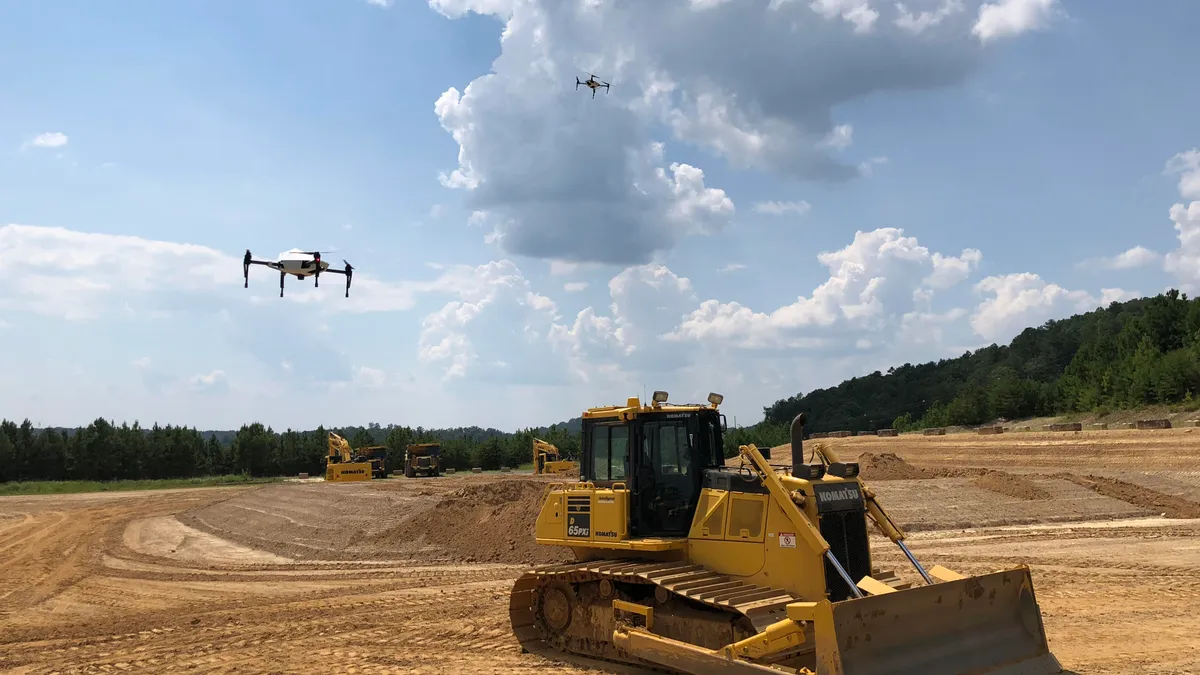Starting a drone program is daunting for general contractors both large and small, but there’s never been a better time than now to take the plunge, says William Pryor, enterprise solutions manager at Skycatch, a drone data and analytics firm.
Of all the commercial applications for unmanned aerial vehicles, construction drone products are among the most mature, he said in a recent webinar, and from a project's design to completion, there are “low-hanging fruits” within arms’ reach of many GCs.
“Drones are bringing a quantified measurement to things that used to be really ‘shoot from the hip’ type of measurements,” Pryor said. “Now we can very easily apply big data principles to managing our jobsites,” for tasks such as earthworks and utilities installation. For example, certain analytics programs that pair with UAVs can measure the amount of dirt in a pile, so that GCs can pretty accurately predict the number of trucks and loads that will be required to remove it.
With “huge amounts of data” at their disposal, GCs and other stakeholders can get a very good idea of what is happening at a site, which plan will work going forward and whether the plan is being adhered to, he said, adding that “it really reduces finger pointing.”
Scaling the value ladder
The use case that’s most valuable to companies just getting their programs off the ground, according to Pryor, is establishing this “common operating picture” through map updates. Whether flights are taking place once a day or once every other week, the ability to document changes occurring onsite throughout the course of the project creates a closed-loop management system, he said, in which improved visibility and consistent feedback allow stakeholders to constantly optimize operations.
The next step up on the value ladder is targeting quantifiable accountability, Pryor said. Companies that can progress from photo and video collection to 2D and 3D modeling using drone data are able to precisely measure what work has been done and understand the financials that factor into that.
“This allows you to manage your subcontractors much more effectively from a pay-application perspective,” he added.
Drone operations serve as a sort of “built-in audit process,” Pryor said. A GC that’s equipped with earthworks quantity data can look at how competitive earth-moving subcontractors’ bids are, he said. Conversely, if those subcontractors can gather the same drone data, they’re able to bid more competitively.
Improved visibility, 4D planning
Safety benefits of drones include the ability to survey and inspect a building facade or a crane high off the ground, for example, without requiring a human worker to get to that height. This translates into major time savings, according to Pryor, because without the use of drones, equipment inspections at heights can sometimes down production for a day.
Yet another value add is the ability to document in-ground utilities and concrete pours. Flyovers during site preparation can sometimes eliminate the need for traditional surveys of in-ground activities and achieve a higher degree of accuracy than is typical for these types of as-builts, he said. And when used to monitor concrete pours, contractors can eliminate pricey X-rays if rework is later needed, Pryor said, because the drone has documented rebar and post-tensioning.
With the tools available, contractors also can fold scheduling and planning activities into their site activity models. These 4D construction simulations can be used to plan crane picks, according to Pryor, allowing project managers to understand the swing radius in relation to other objects on site and to flag and mitigate any risks that are present before the crane starts lifting.
As drone technology becomes easier to use and products continue to mature, Pryor expects a “leapfrog effect” to accompany this year’s industry trends. Companies seeking time savings, better visibility and improved safety should be able to jump to the latest technology and capture value from any of the above use cases, he said.













